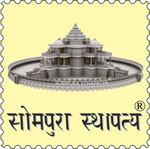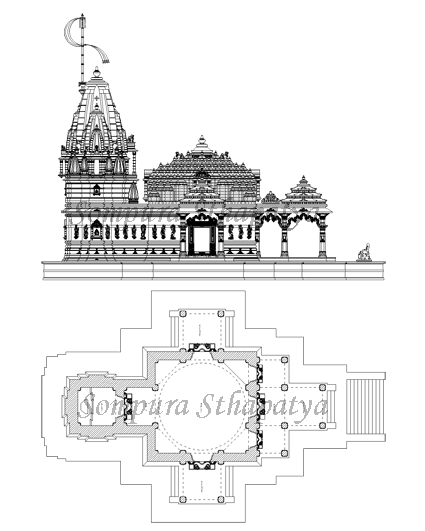Sompura Sthapatya

Temple Architect And Contractor
About The Temple Architecture
The typical Temple architecture is very complex art of the Indian Architecture. A temple architect needs very thorough knowledge of
vastu shilp shastra. There are mainly two formats, one is the north Indian style "Nagar Shaili" and other is south Indian style "Dravidian
Shaili". Not only above mentioned two types of temples but there are fourteen style of temple architecture as per aparajitprichchha.
(1) Nagara (2) Darvid (3) Bhumija (4) Latina (5) Sandhara (6) Vimana (7) Mishraka (8) Virat (9) Valabhi (10) Viman-Nagara (11)
Viman-Pushpak (12) Sinhavalokan (13) Fasanadik (14) Ratharuh

In the northen part of India mostly use Nagara style these days. The main parts of Nagar style temple are Grabh gruh, Koli Mandap, Gudh Mandap, Rang Mandap, Shrungar Chowki, Balanak and Pratoliya.
The Grabh gruh: In Sanskrit temple means "Prasad". The "Grabh gruh" (the sanctum) is the main part of the "Prasad" or it is a hart of the temple. "Grabh gruh" is the place where the establishing the deity. The main positive cosmic energy is generating in this place. If the construction of temple has been strictly followed the norms of vaastu shilp shastra, generating the positive cosmic energy otherwise negative, after the rite of investing idol of deity with life (called “Pran Pratistan”). In “Nirbhram Prasad” (Nagar Shaili) the circumambulation of the deity is on the outer space of the Grabh gruh’s wall. In Sandhara Shaili (“Sabhram Prasad”) creating a hollowness in thickness of Grabh gruh’s wall for the circumambulation of the deity.
The Main Mandap: The two types of mandaps (prayer hall); one is “Gudh Mandap” which is a close with the walls. And second one is called “Rang Mandap” which is an open one with its pillars.This is the place for devotion which is done by the devotees. The place between Mandap and Grabh gruh is called “Koli Mandap”.
The Entrance hall: The small entrance hall in front of the main Mandap and two sides of Mandap called “Shrungar Chowki”. Entrance halls are not covered with wall, open with pillars.
Balanak and Pratoliya: On the main entry gate some temples mainly Jain has “Balanak” or it called “Dev Viman”. Some temples have “Pratoliya” (gate with two or four pillars). Some have both of its.
Some of the main aspects of Nagar style temple are Jagati, Mandovar, Shikhar, Samran, Dwar Shakha, ect.
Jagati: The plinth of the temple called “Jagati”. The main temple is started on its top. It is useful as a “Pradakshina Path” (circumambulation of the deity) in Nirbhram Prasad. “Jagati” is a raised platform touching a temple for people to assemble. Some temple has more than one “Jagati”.
Mandovar: The outer wall of Grabh gruh called “Mandovar”. Mandovar has a very importance in shilp shastra because of obtaining the dimensions of the temple for calculation of vaastu shilp shastra (for temple architecture) from "Mandovar". "Mandovar" has more than one part like Kumbho, Golo, Kewar, Janghi, Bharani, Shiravatti and Chhaju ect. There are many types of "Mandovar", mainly using Nagar Shaili 144 parts, 129 parts of Meru Mandovar and Simple Mandovar, 57 parts and 198 parts of Sandhara Prasad Maha Meru Mandovar. "Mandovar" has a various types of minor limbs called in Sanskrit is “Upang”. "Mandovar" contains most load of Shikhar.
Shikhar: is the tallest part of the temple. It is like a crown of the temple. "Shikhar" is established on a Grabh gruh. Its shape likes to some extend as pyramid. "Shikhar" is one of the major factors to create the cosmic energy in Grabh gruh. There are 1.8 million of different types of Shikhar in ancient Vaastu Shilp methodology, but now a day’s very few designs have been survive. On top of it the pointed part is called "Kalash" like jewel in the crown. "Kalash" has a second importance after deity in temple and its formal installation after deity. "Samran" or "Savarna" is established on a Mandap.
Dwar shakha and Deity: Grabh gruh’s door frame is called "Dwar shakha". To calculate the position of deity in vertical axis in Grabh gruh to make alliance with "Dwar shakha" and eye sight of deity. The perfect calculation of this factor helps in generate positive cosmic energy.
Copyright © 2020 All rights reserved.
Sompura Sthapatya
FF/3, Limbani Complex, Iskcon Bopal Road, Ambli,Ahmedabad - 380 058.Contact: +91 99798 89837 Email: balbhadra@sompura.in